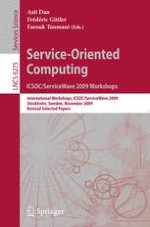2010 | Buch
Service-Oriented Computing. ICSOC/ServiceWave 2009 Workshops
International Workshops, ICSOC/ServiceWave 2009, Stockholm, Sweden, November 23-27, 2009, Revised Selected Papers
herausgegeben von: Asit Dan, Frédéric Gittler, Farouk Toumani
Verlag: Springer Berlin Heidelberg
Buchreihe : Lecture Notes in Computer Science
